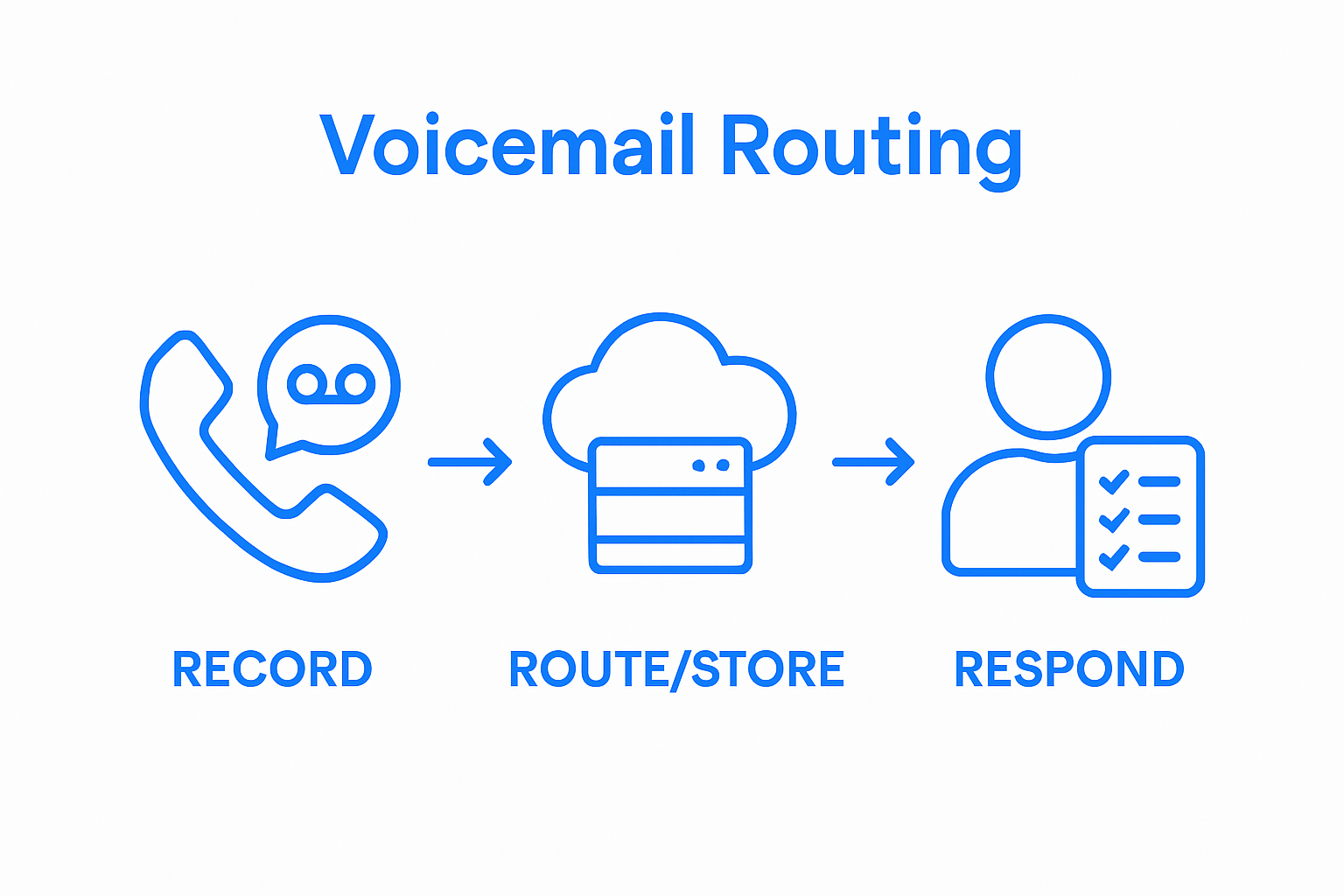Business voicemail systems have quietly become a backbone for keeping teams connected and customers satisfied. The real surprise is that over 80 percent of businesses rely on voicemail as a key part of their daily operations. Most people think voicemail is just an outdated tool for collecting missed messages. Instead, it’s now the launchpad for creating instant transcripts, smart message routing, and real competitive advantages for companies who know how to use it right.
Table of Contents
- What Is Business Voicemail Management?
- Why Effective Voicemail Management Is Crucial For Businesses
- How Business Voicemail Management Works
- Key Components Of A Voicemail Management Workflow
- Real-World Applications Of Voicemail Management
Quick Summary
| Takeaway | Explanation |
|---|---|
| Effective voicemail management boosts efficiency | Proper voicemail systems can streamline communication processes to enhance overall operational efficiency. |
| Automated routing is essential | Intelligent message routing minimizes delays by ensuring messages reach the right people quickly. |
| Transcription improves accessibility | Converting voice messages to text allows team members to prioritize and respond to messages faster. |
| Advanced technology enhances capabilities | Utilizing AI and machine learning improves message handling and response times significantly. |
| Voicemail systems can enhance customer perception | Efficient management of voicemails reassures customers about responsiveness and professionalism in business communications. |
What is Business Voicemail Management?
Business voicemail management represents a comprehensive communication strategy that enables organizations to systematically capture, process, and respond to voice messages across their professional communication channels. Research from communication technology experts indicates that effective voicemail management is crucial for maintaining operational efficiency and ensuring no critical communication falls through the cracks.
Core Components of Voicemail Management
At its fundamental level, business voicemail management involves several interconnected processes that transform traditional voice messaging into a strategic communication tool. These processes include:
- Message Recording: Capturing incoming voice communications with high audio quality and clarity
- Automated Routing: Directing messages to appropriate team members or departments
- Transcription: Converting voice messages into readable text formats
- Storage and Archiving: Securely preserving message records for future reference
Technological Evolution of Voicemail Systems
Modern business voicemail management has dramatically transformed from simple answering machine concepts to sophisticated cloud-based communication platforms. Contemporary systems now integrate artificial intelligence and machine learning to provide advanced features like intelligent message routing, sentiment analysis, and seamless integration with communication platforms.
Businesses leveraging sophisticated voicemail management workflows can significantly enhance their communication efficiency, reduce response times, and create more streamlined communication experiences. By implementing robust voicemail management strategies, organizations ensure that every incoming voice message becomes an opportunity for timely and professional engagement rather than a potential communication barrier.
Below is a table summarizing the key components of modern business voicemail management and their primary functions, helping readers quickly scan how these elements work together.
| Component | Function |
|---|---|
| Message Recording | Captures incoming voice communications with high audio quality |
| Automated Routing | Directs messages to appropriate team members or departments |
| Transcription | Converts voice messages into readable text formats |
| Storage and Archiving | Securely preserves message records for future reference |
| Audio Quality Control | Ensures clear message recording with minimal background noise |
| Metadata Extraction | Collects caller information, timestamp, and communication context |
| Secure Storage | Implements encryption and compliance-grade data preservation protocols |
The goal of business voicemail management extends beyond mere message collection. It represents a critical component of modern organizational communication infrastructure, designed to transform potentially disruptive communications into structured, actionable intelligence.
Why Effective Voicemail Management is Crucial for Businesses
Businesses today operate in an increasingly complex communication landscape where missed messages can translate directly into lost opportunities and diminished professional credibility. Research on organizational communication demonstrates that efficient voicemail management is not just a technical requirement but a strategic business imperative.
Economic and Operational Impact
Ineffective voicemail management carries significant financial and operational consequences. Companies that fail to implement robust voicemail workflows can experience substantial productivity losses and potential revenue reduction. The critical areas of impact include:
- Customer Perception: Unaddressed or delayed voicemails signal poor customer responsiveness
- Operational Efficiency: Manual message tracking consumes valuable employee time
- Communication Reliability: Inconsistent message handling creates organizational communication gaps
Strategic Communication Infrastructure
Modern businesses require communication systems that transform voicemails from potential bottlenecks into strategic assets. Advanced messaging solutions enable organizations to convert voice communications into actionable intelligence, ensuring that every incoming message becomes an opportunity for engagement rather than an administrative burden.
The integration of artificial intelligence and automated routing mechanisms has revolutionized voicemail management. These technologies enable real-time message prioritization, instant transcription, and seamless distribution across team communication platforms. By implementing sophisticated voicemail management strategies, businesses can dramatically reduce response times, improve internal collaboration, and maintain a professional communication standard.
Ultimately, effective voicemail management is about more than technical efficiency.
This table compares the economic and operational impacts of effective versus ineffective voicemail management, allowing readers to quickly grasp the strategic advantages of proper workflow implementation.
| Aspect | Effective Management | Ineffective Management |
|---|---|---|
| Customer Perception | Fast, professional responses | Delayed or unaddressed messages signal poor responsiveness |
| Operational Efficiency | Streamlined communication and reduced workload | Manual tracking consumes valuable employee time |
| Communication Reliability | Consistent and dependable message handling | Inconsistent message handling creates organizational communication gaps |
| Revenue Impact | Increases opportunities, supports growth | Missed messages can lead to lost revenue and business opportunities |
How Business Voicemail Management Works
Advanced communication technologies have transformed traditional voicemail systems into sophisticated, intelligent communication platforms that seamlessly integrate multiple technological processes to capture, process, and distribute voice messages across organizational ecosystems.
Message Capture and Initial Processing
The voicemail management workflow begins with sophisticated audio capture mechanisms that record incoming voice communications with exceptional clarity and precision. These systems utilize advanced digital signal processing technologies to:
- Noise Reduction: Eliminate background interference for crystal clear message recording
- Audio Compression: Optimize voice message file sizes for efficient storage
- Caller Information Extraction: Automatically capture caller metadata like phone number and timestamp
Intelligent Routing and Transcription
Once captured, modern voicemail management systems employ artificial intelligence and machine learning algorithms to transform raw voice messages into actionable communication assets. Intelligent routing technologies enable automatic message distribution based on predefined organizational rules, ensuring that each message reaches the most appropriate recipient with minimal human intervention.
The transcription process converts voice messages into readable text, allowing team members to quickly scan and prioritize communications. Advanced natural language processing algorithms enable accurate transcription, even accounting for different accents, speaking speeds, and industry-specific terminology.
By integrating multiple communication channels and leveraging cutting-edge technologies, business voicemail management systems have evolved from simple message storage mechanisms to dynamic, intelligent communication platforms that enhance organizational responsiveness and operational efficiency.
Key Components of a Voicemail Management Workflow
Research on organizational communication technologies reveals that successful voicemail management workflows are built upon a complex ecosystem of interconnected technological and procedural components designed to transform voice communications into strategic business assets.
Message Capture and Initial Processing
The foundational layer of any robust voicemail management workflow involves comprehensive message capture mechanisms that go beyond simple audio recording. These systems are engineered to capture nuanced communication details, including:
- Audio Quality Control: Ensuring crystal clear message recording with minimal background noise
- Metadata Extraction: Automatically collecting caller information, timestamp, and communication context
- Secure Storage: Implementing encryption and compliance-grade data preservation protocols
Intelligent Routing and Distribution
Once captured, voicemail messages undergo sophisticated routing processes powered by artificial intelligence and predefined organizational rules. Advanced communication integration systems enable intelligent message distribution that considers factors like recipient availability, message urgency, and departmental communication protocols.
The routing mechanism transforms voicemail from a passive communication channel into an active, responsive communication infrastructure. Machine learning algorithms continuously optimize message distribution pathways, ensuring that critical communications reach the most appropriate personnel with minimal latency and maximum efficiency.
By integrating advanced technological components, businesses can create a voicemail management workflow that transcends traditional message handling, turning potential communication barriers into streamlined, intelligent interaction channels that enhance overall organizational responsiveness and productivity.
Real-World Applications of Voicemail Management
Corporate communication research demonstrates that voicemail management systems have become essential tools across various industries, transforming how organizations handle communication and customer interactions.
Professional Service Sector Applications
Legal, medical, and financial service industries leverage advanced voicemail management to ensure compliance, maintain detailed communication records, and provide exceptional client responsiveness. These specialized sectors require sophisticated communication tracking that goes beyond standard message recording:
- Legal Practices: Documenting client communications for potential future reference
- Medical Offices: Securely managing patient communication while maintaining HIPAA compliance
- Financial Institutions: Creating audit trails for regulatory requirements
Enterprise Communication Optimization
Modern businesses utilize voicemail management systems as critical components of their unified communication strategies. Call recording technologies enable organizations to transform voice communications from passive interactions into strategic intelligence gathering tools. These systems provide comprehensive insights by:
Capturing detailed metadata about communication patterns, analyzing caller sentiment, and identifying potential business opportunities through advanced machine learning algorithms. Sales teams can review recorded messages to refine communication strategies, while customer service departments can use transcription tools to improve response protocols.
By integrating voicemail management into broader communication ecosystems, businesses create more responsive, intelligent, and data-driven interaction frameworks that significantly enhance organizational communication efficiency and strategic decision making.
Upgrade Your Voicemail Workflow and Never Miss a Critical Message Again
Are you tired of missed calls turning into missed opportunities? The article highlighted how poor voicemail management can lead to customer frustration, lost business, and time wasted on inefficient manual processes. If your business struggles with slow message routing, unclear audio, or unreliable follow-up, it is time to discover a smarter solution.
Voipcom delivers modern, AI-powered voicemail management that transforms every message into actionable results. Experience features like voicemail-to-email, instant transcription, secure archiving, and smart routing that ensure no message falls through the cracks. Move beyond the old ways and see clear improvements in team response time and customer satisfaction.
Let our local experts set you up with a business phone system built for today’s challenges. Visit our Voipcom website to see how our hosted PBX and AI features can simplify your voicemail workflow and increase your productivity. Start your upgrade now to stay one step ahead.
Frequently Asked Questions
What is business voicemail management?
Business voicemail management is a systematic communication strategy that enables organizations to capture, process, and respond to voice messages effectively across their communication channels.
How does voicemail management improve operational efficiency?
Effective voicemail management reduces missed messages and response times, enhancing customer perception and operational efficiency by streamlining communication processes within the organization.
What advanced features are included in modern voicemail management systems?
Modern systems may include features such as intelligent message routing, voice-to-text transcription, secure storage, and integration with other communication platforms to improve overall communication workflows.
What are the key components of a voicemail management workflow?
The key components include message capture and processing, intelligent routing and distribution, transcription, and secure storage, all designed to turn voice communications into actionable business intelligence.





